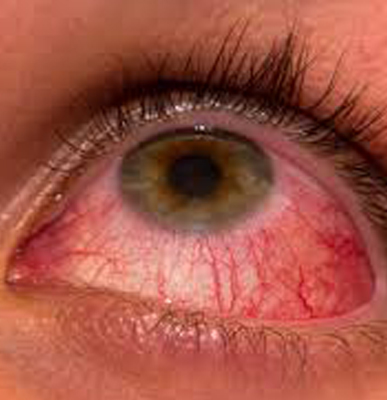What are symptoms of eye allergies?
The most common eye allergy symptoms include:
- red, swollen or itchy eyes
- burning or tearing of the eyes
- sensitivity to light
If accompanied by nasal allergies, you may also have a stuffy, itchy nose and sneezing. You can also have a headache, an itchy or sore throat or coughing.
What causes eye allergies?
An allergy is when the body’s immune system reacts to an allergen that is normally harmless. When an allergen comes in contact with your eye, certain cells within your eye (called mast cells) release histamine and other substances to fight off the allergen. This reaction causes your eyes to become red, itchy and watery.
Allergens in the air — both indoors and out — cause many eye allergies. These allergens include:
- pollen from grass, trees and ragweed
- dust
- pet dander (dead skin cells shed by cats, dogs or other animals)
- mold
- smoke
Allergic reactions to perfume, cosmetics or drugs can also cause the eyes to have an allergic response. Some people may be allergic to the preservative chemicals in lubricating eye drops or prescribed eye drops. They should use preservative-free drops instead if possible.
Sometimes, the eyes can react to other allergens that don’t necessarily come in direct contact with the eye. These can include specific foods or insect bites or stings.
Some people inherit eye allergies from their parents. You’re more likely to have allergies if both of your parents have them than if only one does.
Diagnosis
An ophthalmologist uses a slit-lamp—a microscope with a bright light—to get a closer look at the surface of a young woman’s eyes.
To provide proper treatment, your ophthalmologist will check to see if you have an eye infection or allergic conjunctivitis. They can usually diagnose allergic conjunctivitis easily. They will use a slit-lamp microscope to check for signs of eye allergies, such as swollen blood vessels on the surface of the eye. They will talk to you about your medical history and your family’s history of allergies.
Your ophthalmologist may test for a specific type of white blood cell in your eye. They will do this if your allergies are bad or if it is not clear that you have allergic conjunctivitis. They will gently scrape a tiny area of the conjunctiva and test this tissue for those white blood cells.
How are eye allergies treated?
The key to treating eye allergies is to avoid or limit contact with the substance causing the problem. But you have to know what to avoid. If necessary, an allergist can perform a skin or blood test to help identify the specific allergen(s).















